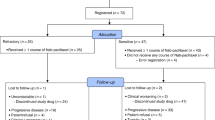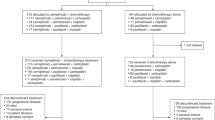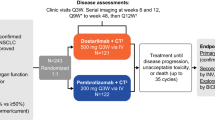Abstract
We report the results of a randomised trial in extensive small-cell lung cancer (SCLC) of a novel approach to palliative chemotherapy. A widely used 3 weekly regimen was compared with the same drugs given at half the dose but twice the frequency with the same intended overall dose intensity (DI). A total of 167 patients defined as having extensive SCLC with adverse prognostic features were randomised to receive either a 3 weekly regimen of cisplatin 60 mg m-2 i.v. on day 1 and etoposide 120 mg m-2 i.v. on day 1 and 100 mg b.d. orally on days 2 and 3 alternating with cyclophosphamide 600 mg m-2 i.v., doxorubicin 50 mg m-2 i.v. and vincristine 2 mg i.v. all on day 1 for a maximum of six courses (3 weekly); or treatment with the same drugs but with each course consisting of half the 3 weekly dose given every 10 or 11 days for a maximum of 12 courses. In the 10/11 day regimen overall response rate was 58.9% (95% CI, 47.9-69.2%) with 12.8% complete responses (CR). For the 3 weekly treatment the overall response rate was 44.9% (95% CI, 35.0-55.5%) with 10.1% CR. Median survival was similar in the two arms at 6.4 months (95% CI, 4.9-7.3 months) and 5.8 months (95% CI, 4.0-6.6 months) respectively. Survival at 1 year was 9.9% (95% CI, 5.0-18.5%) and 8.9% (95% CI, 4.6-16.6%). The 95% CI for the difference in survival at 1 year is -7.09% to +9.09%. Haematological toxicity and treatment delays owing to infection were more frequent with the 10/11 day regimen but other toxicities were equal in both arms. Other aspects of quality of life were measured in a small representative cohort of patients using a daily diary card (DDC). There was a trend of improved quality of life on the 10/11 day arm, but there was little difference between the two treatments. The trial shows that a low-dose/high-frequency regimen with the same DI as conventionally scheduled chemotherapy gives similar response rates and survival. This and other modifications of the schedule may offer new approaches to palliative treatment of advanced cancer. However, in this trial there was no significant benefit in toxicity or other aspects of quality of life.
This is a preview of subscription content, access via your institution
Access options
Subscribe to this journal
Receive 24 print issues and online access
$259.00 per year
only $10.79 per issue
Buy this article
- Purchase on Springer Link
- Instant access to full article PDF
Prices may be subject to local taxes which are calculated during checkout
Similar content being viewed by others
Author information
Authors and Affiliations
Rights and permissions
About this article
Cite this article
James, L., Gower, N., Rudd, R. et al. A randomised trial of low-dose/high-frequency chemotherapy as palliative treatment of poor-prognosis small-cell lung cancer: a Cancer research Campaign trial. Br J Cancer 73, 1563–1568 (1996). https://doi.org/10.1038/bjc.1996.295
Issue Date:
DOI: https://doi.org/10.1038/bjc.1996.295
This article is cited by
-
Defining and analysing symptom palliation in cancer clinical trials: a deceptively difficult exercise
British Journal of Cancer (1999)



